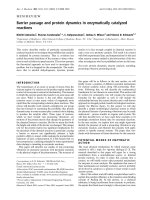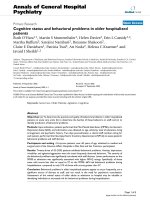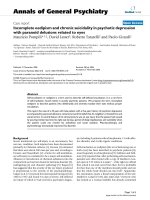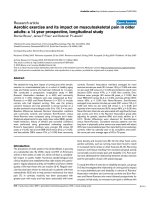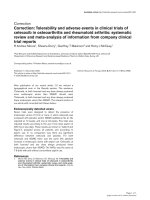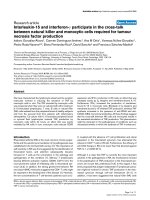Báo cáo y học: "ignal 3 and its role in autoimmunity" pot
Bạn đang xem bản rút gọn của tài liệu. Xem và tải ngay bản đầy đủ của tài liệu tại đây (40.53 KB, 2 trang )
26
APC = antigen presenting cell; CTL = cytotoxic T-lymphocyte; DC = dendritic cell; IFN-γ = interferon-γ; IL = interleukin; IL-1ra = IL-1 receptor
antagonist; MHC = major histocompatibility complex; Th = T helper cell; TLR = Toll-like receptor; TNF = tumor necrosis factor
Arthritis Research & Therapy Vol 6 No 1 Thomas
What is the third signal?
Dendritic cells (DCs) are the professional antigen-present-
ing cells (APCs) of the body, and as such play a key role
in the signaling of T cells for effector responses to antigen.
Various co-stimulatory and adhesive interactions between
DCs and T cells are able to drive proliferative, proinflam-
matory cytokine and cytotoxic effector functions of T cells
[1]. The effector response made to antigen presented by
DCs depends on the co-stimulatory signals delivered to
T cells along with the antigen signal presented in the
context of MHC molecules [2]. Lafferty’s concept of a
second or co-stimulatory signal stands as a key model for
our understanding of the generation of immunity, and also for
our understanding of the basis for peripheral tolerance [3].
In recent years, through the study of interactions taking
place at the immunological synapse, at which T cells are
signaled by antigen-bearing APCs, several groups have
studied the minimal requirements of CD4
+
and CD8
+
T cells for these effector functions. Mescher et al., for
example, have done so using a simple system of beads
conjugated with MHC and antigen – whose density can
be varied – (signal 1), and various membrane co-stimula-
tory molecules (signal 2), such as CD80/86 or CD54
(ICAM-1). In this context, they have shown for CD8
+
T
cells that signals 1 and 2 are sufficient for proliferation and
cytokine production, but that a third signal, IL-12, is
required for cytotoxic effector function [4]. The authors
indicate that IL-12 is not the only soluble factor which can
function as a third signal for CD8
+
T cells, but that it can
be substituted by other, as yet unknown, factors.
In a recent paper, Mescher et al. extend the concept of the
third signal in vivo to show that the presence of signals 1
and 2 but the absence of IL-12 results in peripheral toler-
ance in the CD8
+
T-cell compartment [5]. Thus, CD8
+
T cells are able to proliferate and to produce IFN-γ in vivo
in the absence of IL-12, but this cytokine production and
cytotoxic T-lymphocyte (CTL) activity are limited. The data
are consistent with the work of others, showing the impor-
tant role of IL-12 in driving IFN-γ effector function by T
cells [6]. Further upstream, IL-12 production by DCs has
been shown to be driven by dual TLR (toll-like receptor)
and CD40 signals [7]. In this regard, it is of interest that
the minimum required signals for CD154 (CD40L) expres-
sion by CD4
+
T cells are CD80/86 and CD54, even in the
absence of signal 1 [8].
The signal 3 requirements for CD4
+
T cells are less well
defined. Indeed it is more difficult to define an effector
function beyond cytokine production for CD4
+
T cells that
is equivalent to the “higher order” effector function repre-
sented by CTL activity for CD8
+
T cells. This is paradoxical,
because higher order consequences of CD4
+
T-cell helper
function for B cells, CTL activity and memory are driven
largely by CD154 as well as other CD40-dependent and
-independent co-stimulatory interactions, including OX40,
41BB, ICOS and other members of the B7 family [1]. Nev-
ertheless, using the readout of IFN-γ production by CD4
+
T
cells as a measure of T helper type 1 (Th1) effector func-
tion, Mescher et al. previously suggested that IL-1β could
act as a third signal for CD4
+
T cells [9].
Implications for autoimmune disease
pathogenesis
Although most autoimmune diseases are driven principally
by autoreactivity of CD4
+
T cells to self-antigen presented
in the context of MHC class II, some – notably type 1
diabetes – show a clear association with CD8
+
T-cell
autoreactivity. IL-12 is a major driver in the pathogenesis of
type 1 diabetes in NOD mice, and both IFN-γ and CTL
effector function of CD8
+
T cells in response to self-antigen
are critical for disease development and progression [10].
Over the last 10 years, fascinating roles for IL-1β in
autoimmune disease pathogenesis have also emerged. As
a “third signal,” it appears to have profound roles in the ini-
tiation and persistence of autoimmunity beyond its better-
Viewpoint
Signal 3 and its role in autoimmunity
Ranjeny Thomas
Centre for Immunology and Cancer Research, Princess Alexandra Hospital, University of Queensland, Brisbane, Australia
Corresponding author: Ranjeny Thomas (e-mail: )
Received: 6 Nov 2003 Accepted: 21 Nov 2003 Published: 19 Jan 2004
Arthritis Res Ther 2004, 6:26-27 (DOI 10.1186/ar1033)
© 2004 BioMed Central Ltd (Print ISSN 1478-6354; Online ISSN 1478-6362)
27
Available online />known roles in tissue inflammation, and damage in innate
immunity. Besides its capacity to drive the production of
IFN-γ and IL-2 by CD4
+
T cells directly, IL-1β has been
shown by several groups to act on the DC to enhance the
production of proinflammatory cytokines, including TNFα
and more significantly IL-12, which itself has important
effects on the production of IFN-γ by CD4
+
T cells [11].
Kopf et al. recently showed, in a model of autoimmune
myocarditis, that mice deficient in IL-1 receptor-1 were
resistant to disease induction, but that this resistance
could be overcome by the transfer of wild type DCs
pulsed with autoantigen, since IL-1 signaling of the DCs
now induced IL-12 production and effective autoantigen
presentation [12]. Of interest, Sedgwick et al. have
demonstrated that, rather than IL-12, the more recently dis-
covered IL-23, also with the capacity to drive production of
IFN-γ by CD4
+
T cells, was essential for the pathogenesis
of the autoimmune central nervous system inflammatory
disease, experimental allergic encephalomyelitis [13].
Lastly, an IL-1 receptor antagonist (IL-1ra) deficiency on a
BALB/c but not C57Bl/6 background leads to the sponta-
neous development of inflammatory arthritis [14-16]. This
highlights the critical role of IL-1ra in the constitutive main-
tenance of peripheral tolerance, and in counterbalancing
the proinflammatory effects of IL-1 and IL-17.
Conclusions
Although apparently simple, the concept of a third
(cytokine) signal for T-cell responses to antigen is also
powerful, in that elucidation of third signals in simple in
vitro systems has enabled essential ingredients that drive
spontaneous autoimmunity to be defined. A model for
T-cell activation can be envisaged in which each T cell
integrates a range of proinflammatory, stimulatory and
regulatory signals to determine the effector functions
activated. In this model, one can imagine that in auto-
immune-prone individuals, the contributions of each signal
may be altered, through polymorphisms in the genes
responsible for production of, or response to, the signal.
Alternatively, environmental factors, such as infectious or
toxic signals, may reset the signal threshold. Together, the
genetically determined settings of the T-cell response
mechanism and the environmental exposure history, for
each individual, govern the risk of autoimmune disease
manifestation. Finally, the mandatory contribution of
signals other than antigen to T-cell activation supports the
current model in which interaction of the innate and adap-
tive immune systems determines the outcome of antigen
exposure not only at sites of tissue inflammation and
destruction, but also at the time of antigen presentation.
This model highlights the role of innate and adaptive
immune system interactions in the failure of peripheral tol-
erance. It will be fascinating in the future to extend this
concept to understand the impact of third signals on
failure of mechanisms of central tolerance in the thymus.
Competing interests
None declared.
References
1. Delon J, Stoll S, Germain RN: Imaging of T-cell interactions
with antigen presenting cells in culture and in intact lymphoid
tissue. Immunol Rev 2002, 189:51-63.
2. O’Sullivan B, Thomas R: CD40 and dendritic cell function. Crit
Rev Immunol 2003, 23:83-107.
3. Gill RG, Coulombe M, Lafferty KJ: Pancreatic islet allograft
immunity and tolerance: the two-signal hypothesis revisited.
Immunol Rev 1996, 149:75-96.
4. Valenzuela J, Schmidt C, Mescher M: The Roles of IL-12 in Pro-
viding a Third Signal for Clonal Expansion of Naive CD8 T
Cells. J Immunol 2002, 169:6842-6849.
5.* Curtsinger JM, Lins DC, Mescher MF: Signal 3 determines toler-
ance versus full activation of naive CD8 T cells: dissociating
proliferation and development of effector function. J Exp Med
2003, 197:1141-1151.
6. Banchereau J, Paczesny S, Blanco P, Bennett L, Pascual V, Fay J,
Palucka AK: Dendritic cells: controllers of the immune system
and a new promise for immunotherapy. Ann N Y Acad Sci
2003, 987:180-187.
7. Schulz O, Edwards DA, Schito M, Aliberti J, Manickasingham S,
Sher A, Reis e Sousa C: CD40 triggering of heterodimeric IL-
12 p70 production by dendritic cells in vivo requires a micro-
bial priming signal. Immunity 2000, 13:453-462.
8. Ding L, Green JM, Thompson CB, Shevach EM: B7/CD28-
dependent and -independent induction of CD40 ligand
expression. J Immunol 1995, 155:5124-5132.
9. Curtsinger JM, Schmidt CS, Mondino A, Lins DC, Kedl RM,
Jenkins MK, Mescher MF: Inflammatory cytokines provide a
third signal for activation of naive CD4+ and CD8+ T cells. J
Immunol 1999, 162:3256-3262.
10. Adorini L, Gregori S, Harrison LC: Understanding autoimmune
diabetes: insights from mouse models. Trends Mol Med 2002,
8:31-38.
11. Luft T, Jefford M, Luetjens P, Hochrein H, Masterman KA, Mal-
iszewski C, Shortman K, Cebon J, Maraskovsky E: IL-1 beta
enhances CD40 ligand-mediated cytokine secretion by
human dendritic cells (DC): a mechanism for T cell-indepen-
dent DC activation. J Immunol 2002, 168:713-722.
12. Eriksson U, Kurrer MO, Sonderegger I, Iezzi G, Tafuri A, Hunziker
L, Suzuki S, Bachmaier K, Bingisser RM, Penninger JM, Kopf M:
Activation of dendritic cells through the interleukin 1 receptor
1 is critical for the induction of autoimmune myocarditis. J Exp
Med 2003, 197:323-331.
13.* Cua, DJ, Sherlock J, Chen Y, Murphy CA, Joyce B, Seymour B,
Lucian L, To W, Kwan S, Churakova T, Zurawski S, Wiekowski M,
Lira SA, Gorman D, Kastelein DA, Sedgwick JD: Interleukin-23
rather than interleukin-12 is the critical cytokine for autoim-
mune inflammation of the brain. Nature 2003, 421:744-748.
14. Nakae S, Asano M, Horai R, Sakaguchi N, Iwakura Y: IL-1
enhances T cell-dependent antibody production through
induction of CD40 ligand and OX40 on T cells. J Immunol
2001, 167:90-97.
15. Horai R, Saijo S, Tanioka H, Nakae S, Sudo K, Okahara A, Ikuse T,
Asano M, Iwakura Y: Development of chronic inflammatory
arthropathy resembling rheumatoid arthritis in interleukin 1
receptor antagonist-deficient mice. J Exp Med 2000, 191:313-320.
16. Nakae S, Saijo S, Horai R, Sudo K, Mori S, Iwakura Y: IL-17 produc-
tion from activated T cells is required for the spontaneous devel-
opment of destructive arthritis in mice deficient in IL-1 receptor
antagonist. Proc Natl Acad Sci USA 2003, 100:5986-5990.
Note
* These papers have been highlighted by Faculty of 1000,
a web-based literature awareness service. F1000 evalua-
tions for these papers are available on our website at
/>Correspondence
Ranjeny Thomas, Centre for Immunology and Cancer Research,
Princess Alexandra Hospital, University of Queensland, Brisbane,
4102, Australia. Tel: +61 7 32405365; fax: +61 7 32405946; e-mail:
